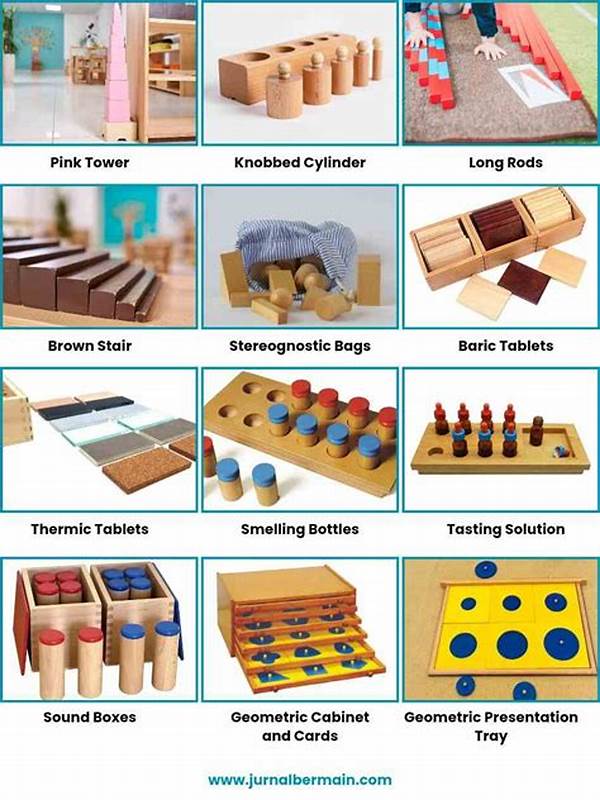Aparatus Montessori
Read More : Maria Montessori
Picture this: a classroom where the tools are more than just educational resources; they’re bridges to a child’s endless curiosity. Welcome to the captivating world of Montessori apparatus—a revolutionary approach sculpted by Maria Montessori that turns traditional learning on its head. These tools, crafted meticulously, aren’t mere objects; they’re gateways to exploration, fostering independence and a palpable joy in learning. Imagine young learners enthusiastically refining their senses with the Pink Tower or discovering the intricacies of mathematics with the Golden Beads. It’s not just education; it’s an adventure of discovery!
Montessori apparatus captivates not only by its structured beauty but through its core philosophy—nurturing self-directed growth. Each piece invites children to solve problems, refine their motor skills, and engage their senses. It transforms classrooms into dynamic learning environments where children are at the helm of their educational journeys, unearthing knowledge in bite-sized, palpable chunks. In our fast-paced world, Montessori education offers a refreshing pause, where learning is tactile and engaging, ensuring that core skills are cultivated effortlessly and naturally.
How Montessori Tools Transform Learning
Why does Montessori apparatus work so effectively in nurturing young minds? It taps into the natural love for learning that children inherently possess. Picture a child, their brows furrowed in concentration, stacking the iconic Pink Tower, each block incrementally different, encouraging visual discrimination. The excitement bubbling over as they accomplish tasks independently is unparalleled. The Montessori approach cleverly interweaves play with development, making education an immersive experience.
Exploring the Unique Features of Montessori Apparatus
The magic of Montessori apparatus lies in its ability to speak the language of children. It understands that education is not about the mere transfer of knowledge but the inspiring journey of discovery. What elements make these tools so revolutionary? Each apparatus is scientifically designed to isolate a particular concept, fostering deep understanding through repetition and manipulation. It gently shifts the child from dependence to autonomy, crafting learners who are confident, capable, and inquisitive.
—
An Introduction to Montessori Materials
Nestled within the heart of every vibrant Montessori classroom is an assortment of intriguing materials, collectively known as the apparatus Montessori. These tools are not randomly chosen; they are the fruit of meticulous research and educational philosophy aimed at catalyzing children’s learning.
The Montessori materials resonate with a unique selling proposition: they don’t restrict learning; they encourage an unending quest for knowledge. Imagine wooden blocks whispering secrets of geometry, or colored beads that simplify the enigma of mathematics. It’s a tactile wonderland where children aren’t just spectators but active participants in their education.
The Philosophy Behind Montessori Apparatus
The driving philosophy behind the Montessori apparatus is centered on respect for a child’s natural psychological development. Dr. Maria Montessori believed that children learn best in an environment prepared with materials that stimulate their curiosity and encourage them to explore independently. It’s this attention to child-centered education that makes Montessori tools exceptionally effective. The apparatus is designed to draw in inquisitive minds, facilitating a symphony of learning that is both engaging and profound.
The Impact of Montessori Materials on Child Development
Every piece of Montessori apparatus is a testament to the seamless fusion of learning and play. It’s not just about acquiring knowledge; it’s about fostering an environment that promotes creativity, critical thinking, and problem-solving. Imagine a scenario where education is not stressful but joyful, where children rush to engage with materials that challenge and stimulate their intellect. This is the beauty and impact of Montessori’s vision.
—
8 Actions Related to Montessori Apparatus
—
Getting to Know Montessori Apparatus
Imagine a realm where learning is seamlessly woven into the fabric of daily play—a hallmark of the Montessori ecosystem. Montessori apparatus forms the backbone of this world, offering a smorgasbord of opportunities for exploration and development that aligns with children’s natural curiosity and learning patterns.
In every Montessori classroom, these specially-designed tools facilitate experiential learning, enabling children to dissect complex concepts through tangible, hands-on interaction. Whether it’s sensorial, practical life, or language skills, every aspect of development is meticulously catered to by these remarkable tools.
Montessori Apparatus in Practice
How do these marvelous instruments work in practice? Each apparatus is designed with a specific learning objective but leaves room for creativity and innovation. Children are encouraged to interact with the materials as independent learners. They construct their pathways to knowledge, guided subtly by the teacher who acts more as a mentor than an instructor. This dynamic shifts the educational paradigm, fostering a conducive atmosphere for organic learning processes.
The Role of Teachers and Parents in Montessori Education
Parents and teachers play an instrumental role in the Montessori method, aligning their support and guidance to optimize the child’s learning experience. They are facilitators, ensuring that the environment is both challenging and nurturing, providing the children with the freedom to explore within safe boundaries. The collaborative effort between apparatus and guidance paints the ideal backdrop for holistic development.
—
Key Elements of Montessori Apparatus
Investing in Montessori materials is not just about providing tools; it’s about opening gateways to uncharted territories of learning and understanding for children. These remarkable apparatus not only enrich educational experiences but also build the framework for life-long learning and success.
